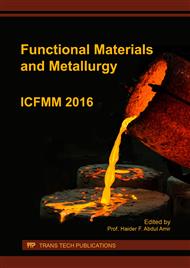[1]
P.H. Yannakopoulos, A. P. Skountzos and M. Vesely: Influence of Ionizing Radiation in Electronic and Optoelectronic Properties of III–V Semiconductor Compounds, Science Direct, Microelectronics Journal 39 (5), p.732–736 (2008).
DOI: 10.1016/j.mejo.2007.12.025
Google Scholar
[2]
I. Fetahović, M. Pejović, and M. Vujisić: Radiation Damage in Electronic Memory Devices, International Journal of Photoenergy (2013).
DOI: 10.1155/2013/170269
Google Scholar
[3]
E. Wendler: Mechanisms of damage formation in semiconductors, Nuclear Instruments and Methods in Physics Research Section B: Beam Interactions with Materials and Atoms, 267(16), pp.2680-2689 (2009).
DOI: 10.1016/j.nimb.2009.05.059
Google Scholar
[4]
M. Hou, C. J. Ortiz, C. S. Becquart, C. Domain, U. Sarkar and A. Debacker: Microstructure evolution of irradiated tungsten: Crystal effects in He and H implantation as modelled in the Binary Collision Approximation, Journal of nuclear materials, 403(1), pp.89-100 (2010).
DOI: 10.1016/j.jnucmat.2010.06.004
Google Scholar
[5]
A. E. Sand, S. L. Dudarev and K. Nordlund: High-energy collision cascades in tungsten: Dislocation loops structure and clustering scaling laws, EPL (Europhysics Letters), 103(4), 46003 (2013).
DOI: 10.1209/0295-5075/103/46003
Google Scholar
[6]
A. Burenkov, M. Sekowski, V. Belko and H. Ryssel: Angular distributions of sputtered silicon at grazing gallium ion beam incidence, Nuclear Instruments and Methods in Physics Research Section B: Beam Interactions with Materials and Atoms, 272, pp.23-27 (2012).
DOI: 10.1016/j.nimb.2011.01.025
Google Scholar
[7]
J. F. Ziegler and J. P. Biersack: The Stopping and range of ions in matter, Treatise on Heavy-Ion Science: Volume 6: Astrophysics, Chemistry, and Condensed Matter, 95 (2012).
DOI: 10.1007/978-1-4615-8103-1_3
Google Scholar
[8]
J. F. Ziegler, M. D. Ziegler and J. P. Biersack: SRIM–The stopping and range of ions in matter, Nuclear Instruments and Methods in Physics Research Section B: Beam Interactions with Materials and Atoms, 268(11), pp.1818-1823 (2010).
DOI: 10.1016/j.nimb.2010.02.091
Google Scholar
[9]
M. Nastasi, J. Mayer, and J. K. Hirvonen: Ion-solid interactions: fundamentals and applications. Cambridge University Press (2004).
Google Scholar
[10]
C. Claey, and E. Simoen: Radiation Effect in Advanced Semiconductor Material and Devices, Spring-Verlag Berlin Heidelberg, NY, (2002).
Google Scholar
[11]
D. A. Neamen: An introduction to semiconductor devices, 4th Ed., Singapore: McGraw-Hill (2011).
Google Scholar
[12]
F. A. A. Haider and F. P. Chee: Monte Carlo study of alpha (α) particles transport in nanoscale gallium arsenide semiconductor materials, In INTERNATIONAL CONFERENCE ON FUNDAMENTAL AND APPLIED SCIENCES 2012: (ICFAS2012) (Vol. 1482, No. 1, pp.559-563), AIP Publishing (2012).
DOI: 10.1063/1.4757534
Google Scholar


